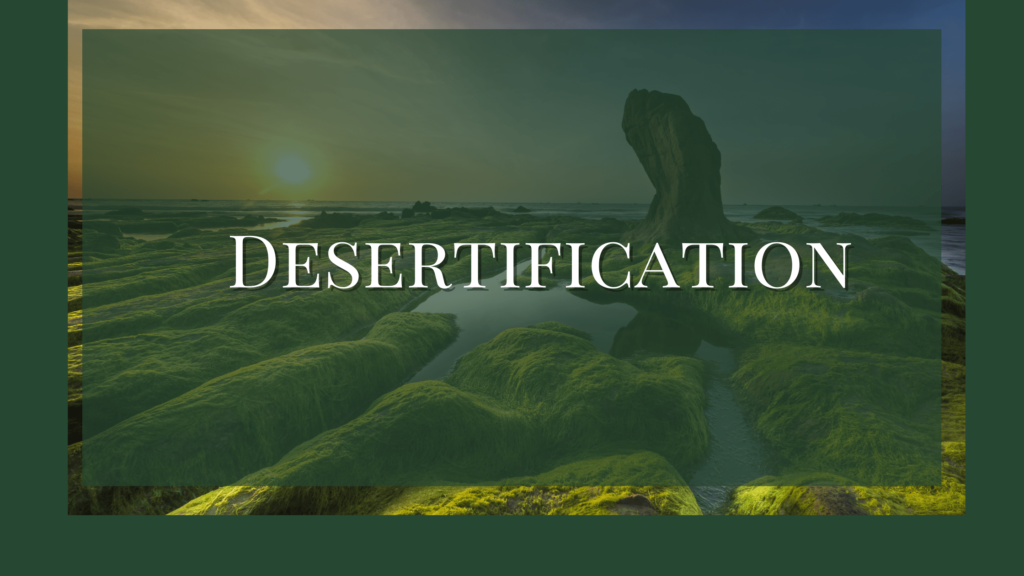Desertification is the process of conversion of an ecosystem into a desert through various activities. It can be caused by human activities and natural causes. The common causes include natural disasters, tillage practices, urbanization, overgrazing, climate change, over-drafting of groundwater, deforestation, etc.
Desertification is considered one of the greatest challenges of modern times that leads to climate change.
What is Desertification Explain
The definition of desertification says that it is the land degradation process in semi-arid, arid, and dry sub-humid areas where the vegetation gradually disappears, due to human activities and climate changes. These areas are collectively called drylands. It is not the expansion of existing deserts but the gradual transformation of a non-desert ecosystem into a desert.
The process of desertification is slow and self-accelerating, manifesting through loss of vegetation cover, reduced productivity in agriculture, soil erosion, drought, water scarcity, poverty, etc.
Desertification is not the same as desertisation. Desertisation is a natural deterioration of an ecosystem that eventually becomes a desert. The Sahara Desert is an example of desertisation. There was no manual intervention in its conversion from a flourishing green land into a desert.
Causes of Desertification
The main causes of desertification are,
- Cutting down trees and exploitation of forest resources leads to deforestation.
- Over-exploitation of natural resources and irresponsible management.
- Poor agricultural practices including the use of chemical fertilizers, unprotected soil, and the inability to rotate crops.
- Overgrazing prevents the regeneration of vegetation.
These steps lead to a gradual loss of biodiversity as the land becomes uninhabitable for plants. There will be a drop in the availability of crops. The loss of vegetation leads to food scarcity for the livestock and humans.
The loss of vegetation gradually spread to the forest area, eventually leading to a shortage of wood resources. Poor management of resources will also lead to water scarcity.
Effects of Deforestation
The destruction of forests by humans and their activities can have major consequences on the habitat and the species living there. Here are the main effects of deforestation.
- Deforestation in the Himalayan region has led to the loss of several natural habitats and has threatened several natural resources.
- Many species of flora and fauna are either endangered or on the verge of extinction.
- Frequent natural disasters such as landslides, floods, storms, earthquakes, etc., are a consequence of deforestation.
- Deforestation of the Himalayan range has resulted in water shortage, floods, sedimentation into the rivers, reduced availability of fodder and grazing land, etc.
- The reduction in the availability of fodder has affected animal life and there is a steady reduction in animals of the hill ecosystem.
- The livestock population will be higher than the available natural resources and land that can sustain them.
- The availability of underground water has gone deeper affecting other water bodies. This has led to the drying of ponds, wells, lakes, rivers, etc., in summer.
- The cutting down of forest trees has affected the natural habitats of several plants, especially medicinal plants in the wild.
- With a lesser number of trees, there is a huge amount of carbon dioxide escaping into the atmosphere contributing to global warming. Otherwise, trees would have used this carbon dioxide for photosynthesis.
- Cutting down the trees will lead to more instances of soil erosion and its degradation.
- Moreover, short-term deforestation could lead to long-term devastation and economic crises due to the destruction of natural ecosystems.
- Studies have also shown that deforestation could lead to loss of habitat of animals which would come close to human habitats. This intermingling could lead to disease outbreaks such as malaria due to close contact with the vectors.
- Most importantly, the lack of enough trees has led to more air pollution making outdoor air unfit for humans, animals, and plants.
How to Prevent Desertification?
- Sustainable management of natural resources.
- Conservation of fertile soil.
- Proper management of water resources and preventing water pollution.
- Controlled use of land which includes proper agricultural practices, healthy livestock management, etc.
- Protect the soil through the preservation of the vegetation. This will provide barriers against soil erosion and also stabilize the dunes.
- Conduct awareness programs to reduce activities that cause climate change.
- Switching to organic farming, promoting crop rotation, etc.
- Actively commit to reforestation to regenerate the forest resources and vegetation.
References
- I. (2021, April 22). DESERTIFICATION. Iberdrola.
- Impacts of deforestation. (n.d.).
- Morand, S., & Lajaunie, C. (2021). Outbreaks of Vector-Borne and Zoonotic Diseases Are Associated With Changes in Forest Cover and Oil Palm Expansion at Global Scale. Frontiers in Veterinary Science, 8, 661063. https://doi.org/10.3389/fvets.2021.661063




